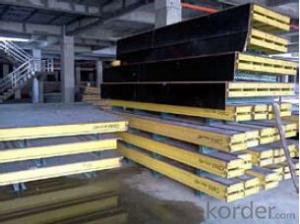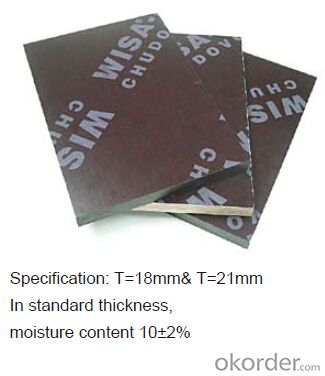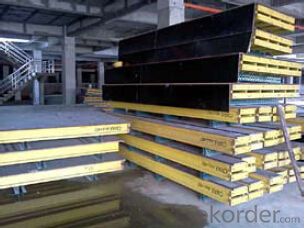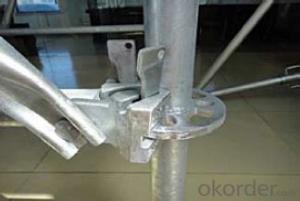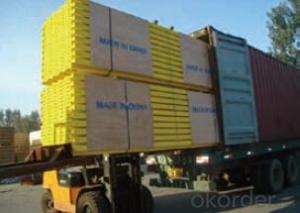Plywood formwork system for formwork and scaffolding
- Loading Port:
- Tianjin
- Payment Terms:
- TT OR LC
- Min Order Qty:
- 50 m²
- Supply Capability:
- 1000 m²/month
OKorder Service Pledge
Quality Product, Order Online Tracking, Timely Delivery
OKorder Financial Service
Credit Rating, Credit Services, Credit Purchasing
You Might Also Like
Plywood --- make perfect concrete surface
WISA-Form Birch is a coated special plywood using in the formwork systems where high
requirements are set on the concrete surface and the times of reuses.
With CNBM timber beam & WISA plywood, the formwork is low weight but high load capacity, it is
widely used in construction.
Characteristics:
◆ Component with high standardization.
◆ Assembling in site, flexible application.
◆ Light weight, easy transportation and storage.
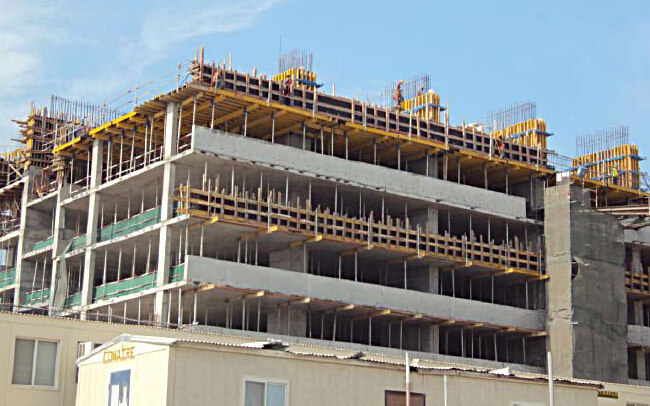
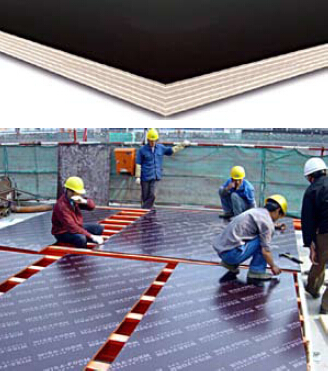
- Q: How does steel formwork accommodate for different concrete compaction methods?
- Steel formwork is an adaptable construction material capable of accommodating various concrete compaction methods with ease. Its strength and rigidity are key advantages, allowing it to withstand the forces exerted during compaction techniques. When utilizing compaction methods such as hand tamping or a vibrating poker, steel formwork provides a stable and secure surface for applying the necessary forces. The rigid and tightly connected steel panels ensure that the concrete remains in place and maintains its shape throughout the compaction process. This facilitates efficient and effective compaction, resulting in a uniform and high-quality concrete finish. In instances where mechanical compaction methods such as plate compactors or vibrating rollers are employed, steel formwork readily adapts to the added weight and vibrations. The robustness of the steel panels enables them to support heavy equipment and absorb vibrations without deformation or cracking. This guarantees even compaction of the concrete, eliminating any potential weak spots or voids. Moreover, steel formwork can be easily adjusted and modified to accommodate diverse compaction methods. The panels can be effortlessly repositioned or removed to allow proper access and movement for compaction equipment. Additionally, steel formwork can be tailored to specific shapes and sizes to meet the requirements of the compaction method employed. In summary, steel formwork offers a dependable and flexible solution for accommodating various concrete compaction methods. Its strength, rigidity, and adaptability make it an ideal choice for construction projects that necessitate efficient and effective compaction techniques.
- Q: What are the common design considerations for steel formwork systems?
- There are several common design considerations for steel formwork systems that should be taken into account to ensure the successful construction of a project. Firstly, the load-bearing capacity of the steel formwork system is a crucial consideration. The formwork must be able to safely support the weight of the concrete being poured and any additional loads such as workers or equipment. This requires careful calculation and analysis to determine the appropriate thickness and reinforcement of the steel formwork. Secondly, the formwork system should be designed to provide adequate stability and resistance against lateral forces. This is particularly important in high-rise or complex structures where wind or seismic loads may be significant. The design should incorporate bracing and anchorage systems to ensure the formwork remains stable during construction. Another important consideration is the ease of assembly and disassembly of the steel formwork system. The design should allow for efficient installation and removal, minimizing labor and time requirements. This often involves the use of modular components and standardized connections that can be easily assembled and dismantled. Additionally, the formwork system should be designed to accommodate any necessary adjustments or modifications. Construction projects often require changes or adaptations during the construction process, and the formwork should be flexible enough to accommodate these changes without compromising structural integrity. Furthermore, safety considerations play a vital role in the design of steel formwork systems. The formwork should be designed to provide a safe working environment for construction workers, with features such as handrails, access platforms, and non-slip surfaces. Additionally, the design should consider potential hazards, such as sharp edges or protruding elements, and incorporate appropriate safety measures to mitigate these risks. Lastly, the durability and longevity of the steel formwork system should be taken into account. It should be designed to withstand the harsh conditions of construction, including exposure to weather, chemicals, and repeated use. This may involve the use of corrosion-resistant materials or protective coatings to ensure the longevity and performance of the formwork system. In conclusion, the common design considerations for steel formwork systems include load-bearing capacity, stability against lateral forces, ease of assembly and disassembly, adaptability to changes, safety features, and durability. By carefully considering these factors, engineers can design a steel formwork system that meets the specific requirements of a construction project and ensures its successful execution.
- Q: How does steel formwork handle concrete setting time and curing temperature?
- Steel formwork is a preferred choice for handling concrete setting time and curing temperature due to its excellent heat transfer properties and durability. Steel, being a good conductor of heat, helps in dissipating the heat generated during the hydration process of concrete, thus accelerating its setting time. This allows for a faster construction process and reduces the overall project timeline. Additionally, steel formwork can withstand high curing temperatures without deforming or deteriorating. This is particularly important in cases where concrete requires high-temperature curing to achieve the desired strength and durability. Steel's ability to withstand high temperatures ensures that the formwork remains intact and stable, providing the necessary support to the concrete during the curing process. Furthermore, steel formwork's strength and rigidity prevent any deformation or movement during the concrete setting and curing stages. This is crucial for maintaining the desired shape, size, and surface finish of the concrete structure. The use of steel formwork ensures that the concrete remains in place and does not experience any undesirable shifts or displacements during the curing process. In conclusion, steel formwork is an ideal choice for handling concrete setting time and curing temperature due to its excellent heat transfer properties, ability to withstand high temperatures, and its strength and rigidity. Its usage facilitates faster setting times, allows for high-temperature curing, and ensures the stability and integrity of the concrete structure during the curing process.
- Q: How does steel formwork affect the overall flexibility of the structure?
- Steel formwork can significantly enhance the overall flexibility of a structure. The use of steel formwork allows for greater accuracy in shaping concrete elements and provides excellent structural stability. Its strength and rigidity enable the construction of complex shapes and intricate designs, resulting in a more flexible and versatile structure. Additionally, steel formwork offers the advantage of being reusable, allowing for cost-effective construction methods and further enhancing flexibility in future modifications or renovations.
- Q: What are the common safety precautions when working with steel formwork in high winds?
- When working with steel formwork in high winds, there are several common safety precautions that should be followed to ensure the safety of workers and the integrity of the formwork. 1. Secure the formwork: It is essential to properly secure the steel formwork to prevent it from being blown away by strong winds. This can be achieved by using appropriate anchoring methods such as tie-downs, braces, or clamps. Adequate bracing should be installed at regular intervals to provide additional stability. 2. Regular inspections: Regular inspections of the formwork should be conducted before, during, and after high wind events. This includes checking for any signs of damage or weakness in the formwork structure, loose connections, or compromised anchoring. Any issues identified should be addressed promptly to prevent accidents or further damage. 3. Reinforce the formwork: In areas with high wind activity, it may be necessary to reinforce the steel formwork to withstand the stronger forces. This can be done by adding additional support beams, cross-bracing, or wind-resistant features to the structure. The reinforcement should be designed and implemented by a qualified engineer to ensure its effectiveness. 4. Provide personal protective equipment (PPE): Workers should be provided with appropriate personal protective equipment to protect them from potential hazards during high wind conditions. This may include safety helmets, goggles, gloves, and high-visibility clothing to enhance visibility for other workers and equipment operators. 5. Monitor weather conditions: Regular monitoring of weather conditions is crucial when working with steel formwork in high winds. If there are predictions or signs of strong winds, work should be temporarily suspended until the wind speeds decrease to safe levels. It is important to have a reliable weather monitoring system in place to stay informed about changing weather conditions. 6. Training and communication: All workers involved in working with steel formwork should receive proper training on the safety precautions and procedures to follow during high wind situations. Clear communication channels should be established to ensure that workers are aware of any changes in weather conditions or safety protocols. By following these common safety precautions, the risks associated with working with steel formwork in high winds can be minimized, ensuring the well-being of workers and the successful completion of the construction project.
- Q: What are the typical sizes and dimensions of steel formwork panels?
- Steel formwork panels come in a variety of sizes and dimensions, depending on the specific application and project requirements. However, the construction industry widely utilizes some common standard sizes. For wall formwork, steel panels typically have a height of about 2.4 meters and a width of 0.6 meters. These panels are available in different thicknesses ranging from 12mm to 18mm. They are designed to easily connect and stack together, forming a strong and stable wall formwork system. Slab formwork panels, on the other hand, tend to be larger. The standard size for these panels is approximately 1.2 meters in width, with the length varying according to the desired slab size. Like wall formwork panels, slab formwork panels are also offered in different thicknesses to support the weight and load requirements of the concrete slab. Apart from the standard sizes, customized steel formwork panels can be produced to meet specific project needs. These custom panels can be tailored with specific dimensions, shapes, and configurations to accommodate irregular or unique construction requirements. It's important to remember that while steel formwork panels offer strength and durability, they can be heavy and require suitable lifting and handling equipment for installation and removal. Moreover, it is crucial to follow proper safety measures when using steel formwork panels to ensure worker safety and project success.
- Q: Can steel formwork be used for energy-efficient concrete buildings?
- Energy-efficient concrete buildings can utilize steel formwork. The strength, durability, and versatility of steel formwork make it a suitable option for constructing energy-efficient structures. Precise design and construction are achievable with steel formwork, which is essential for achieving energy efficiency in buildings. Architects and engineers can customize steel formwork to create intricate designs and complex shapes, allowing for the incorporation of energy-efficient features like insulated walls, solar shading devices, and efficient HVAC systems. Furthermore, steel formwork offers excellent thermal conductivity, which helps maintain consistent indoor temperatures and reduces energy consumption. By using steel formwork, concrete walls and floors can be designed with insulation materials that provide high thermal resistance, minimizing heat transfer through the building envelope. This reduces the energy required for heating and cooling, resulting in improved energy efficiency. In addition, steel formwork is easily reusable, reducing construction waste and promoting sustainability. It can be dismantled and reassembled for multiple projects, making it a cost-effective and environmentally friendly choice. Choosing steel formwork for energy-efficient concrete buildings not only minimizes energy consumption but also reduces the overall environmental impact. To conclude, steel formwork is an effective choice for constructing energy-efficient concrete buildings. Its strength, durability, versatility, and thermal conductivity make it suitable for incorporating energy-efficient features into the building design. Moreover, its reusability promotes sustainability, making steel formwork a viable option for creating energy-efficient structures.
- Q: Position of horizontal construction joint of shear wall. The first layer is higher than the standard layer, the large template in accordance with the standard layer, the first part of the difference with the roof can be poured?
- Large template in accordance with the standard layer, the difference between the first part of the roof can be poured?
- Q: Are there any specific safety guidelines for steel formwork installation?
- Steel formwork installation requires adherence to specific safety guidelines. The following key safety measures should be observed: 1. Training and Competency: All personnel involved in steel formwork installation must undergo proper training and possess the necessary skills. This includes knowledge of equipment, understanding of installation procedures, and awareness of potential hazards. 2. Personal Protective Equipment (PPE): Workers must wear appropriate PPE, including hard hats, safety glasses, gloves, and steel-toed boots. This is to protect against potential head, eye, hand, and foot injuries. 3. Inspection and Maintenance: Regular inspections should be conducted on the steel formwork and associated equipment to identify any defects or hazards. Immediate repairs or replacements should be carried out for damaged or faulty parts to ensure safety during installation. 4. Hazard Identification and Control: Before commencing installation, a comprehensive assessment of the work area must be performed to identify potential hazards, such as overhead power lines, uneven ground, or confined spaces. Adequate measures, like erecting barriers, using warning signs, or implementing fall protection systems, should be taken to control these hazards. 5. Manual Handling: Proper lifting techniques should be employed to prevent back injuries or strains. For heavy or awkward loads, the use of mechanical aids such as cranes or hoists should be considered. 6. Fall Protection: Due to the inherent risk of falls during steel formwork installation, especially when working at heights, the use of adequate fall protection systems, such as guardrails, safety nets, or personal fall arrest systems, is essential to prevent accidents and safeguard workers. 7. Communication and Coordination: Clear communication and coordination among the installation team are crucial for a safe installation process. Regular safety briefings, ensuring clear understanding of roles and responsibilities, and maintaining an open line of communication for reporting safety concerns are essential. It is important to note that these guidelines may vary depending on the specific project, local regulations, and industry standards. Therefore, it is advisable to consult with relevant authorities, such as the project engineer or site safety officer, to ensure compliance with all necessary safety requirements.
- Q: Can steel formwork be used in areas with high wind loads?
- Yes, steel formwork can be used in areas with high wind loads. Steel formwork is known for its strength, durability, and stability, making it a suitable choice for construction projects in areas with high wind loads. The robustness and rigidity of steel formwork allow it to withstand the force and pressure exerted by strong winds, ensuring the safety and stability of the structure being built. Additionally, steel formwork offers a higher level of resistance to deformation and movement compared to other types of formwork materials, making it more reliable in areas prone to high wind loads. However, it is crucial to ensure that the steel formwork is properly secured and anchored to the ground to further enhance its resistance against wind loads.
Send your message to us
Plywood formwork system for formwork and scaffolding
- Loading Port:
- Tianjin
- Payment Terms:
- TT OR LC
- Min Order Qty:
- 50 m²
- Supply Capability:
- 1000 m²/month
OKorder Service Pledge
Quality Product, Order Online Tracking, Timely Delivery
OKorder Financial Service
Credit Rating, Credit Services, Credit Purchasing
Similar products
Hot products
Hot Searches
Related keywords

